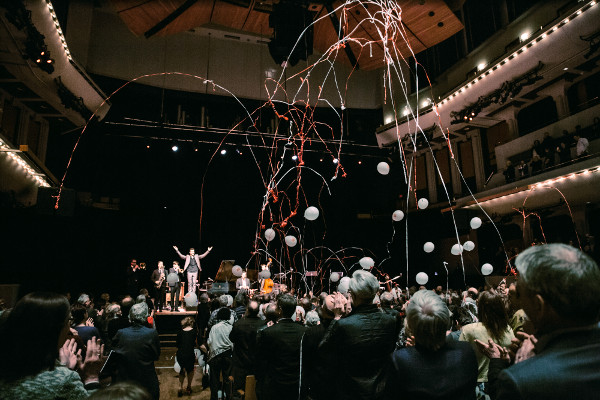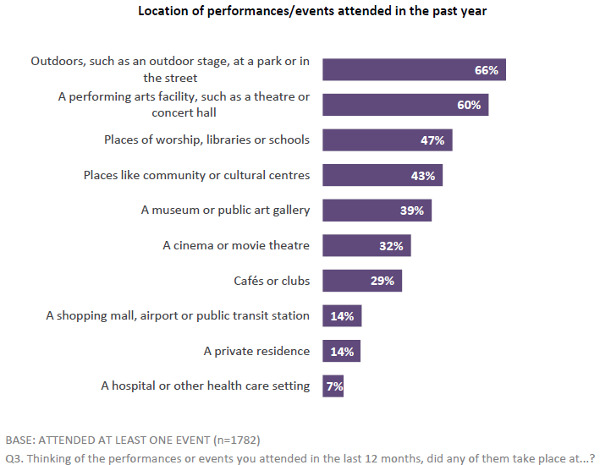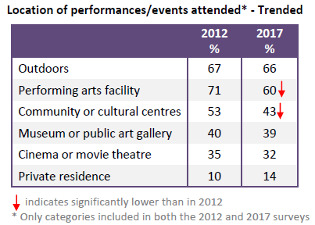March 12, 2018 – As the demographics of the Canadian population change, so are their habits for accessing live performances and other forms of entertainment. In this last article of the “Attendance Trends” series, we will look at preferred locations for live performance attendance.
 |
According to the Arts and Heritage Access and Availability Survey, attendance of performances and arts events is as strong as ever. In 2016-2017, 87% Canadians attended at least one performance or arts event (including craft shows and visual arts exhibits). Overall attendance is also high (80%+) across all regions and most segments of the Canadian population. These are the highest attendance ratios ever registered by the Access and Availability Survey (previous iterations of this survey were conducted in 2012, 2007 and 2001).
However, depending on the types of venues they use, some multi-displinary presenters may not have witnessed much growth in their ticket sales. To the contrary.
 |
 |
According to the Access and Availability Survey, culturally-active Canadians attend performances in a broad range of facilities, including libraries, schools, clubs, cafés, shopping malls, private residencies, long-term care facilities, as well as outdoors. As mentioned in a previous post, attending arts events in several venues is most widely reported by Canadians under 25. Attendance at most venues increases with level of education; the exception is that the attending an event at a shopping mall/public transit is higher among those without a postsecondary education (18%).
Compared to the 2012 survey, Canadians remained loyal to most types of facilities, except two: reported attendance at performing arts facilities is down from 71% to 60% and reported attendance at community or cultural centres is down 53% to 43%. Both of these are statistically significant drops, and ought to be taken seriously by all stakeholders in the performing arts sector.
Notably, reported attendance at a performing arts facility varies significantly with household income (ranging from 46% with incomes under $40,000 to 71% with incomes over $100,000). Attendance at a performing arts facility is also affected by the degree to which Canadian believe these arts events impact their quality life and that of their family (ranging from 33% among those who consider arts events are not at all important for their quality of life to 72% for those who find them very important).
The strong correlation between attendance at a performing arts facility and income can be interpreted in various ways. First, one can see it as a serious indicator of demand elasticity: the more ticket prices increase, the fewer potential buyers are willing to pull out their wallet. Second, one could posit that there are disposable income thresholds below which attendance at a performing arts facility simply becomes unaffordable (irrespective of the household debt to disposable income ratio, which reached a record-high level in 2017). Indeed, as one can see in the chart below, attendance drops significantly below $40,000 and surges above $100,000. As we highlighted in a previous post on attendance barriers, the Canadian Index of Wellbeing deteriorated significantly as a result of the growing income gap. Although we wouldn’t want to pit arts attendance issues against income inequality issues, we shouldn’t deny the likelihood that there is a connection between the two.
Attendance at Performing Arts Facilities and Income
| Household income | <$40,000 | $40-80,000 | $80-100,000 | $100,000 + |
| Attendance at a performing arts facility in the last 12 months | 46% | 58% | 62% | 71% |
Source: Environics Research, Arts and Heritage Access and Availability Survey, 2016-2017
As to the connection between attendance of performing arts events and the level of importance of these events to quality of life, this suggests we still have to deal with perception and attitudinal issues. As much as we tried to convey the value of presenting in the broader Canadian society, we are still not seeing the arts considered in public policy as a driver of wellbeing. For example, the 2018 federal budget noted the importance of physical activity to health and wellbeing by committing funding to Participaction and to supporting women and girls in sport, but didn’t answer the call from the arts sector to invest in performing arts presentation, whose rationale yet made the connection between arts participation and wellbeing. Similarly, the Province of Quebec recently released details about a comprehensive Health Prevention Policy. The policy sets targets for many indicators of a healthy and active lifestyle, but arts participation isn’t part of it. Considering the wealth of research evidence on arts and health, governments should no longer have to make either/or decisions between sports and the arts in health promotion. Both are important and should be equally valued.
Finally, independently of all the indicators in the Access and Availability Survey, there are undeniable discoverability gaps that need to be addressed. Among all the facility types included in the survey, the performing arts venue stands out as the only facility whose primary and almost exclusive purpose is the presentation of performing arts events. Theatres and concert halls are indeed very “specialized” facilities. They are very seldom visited by the public other than for the purpose of attending a performing arts event (or, occasionally, a private reception). As such, performing arts venues miss out on discoverability opportunities arising from on-site publicity (i.e., a library goer seeing a poster about an upcoming spoken word event in the library), word of mouth from regular clients (i.e., a loyal café customer inviting friends to an upcoming songwriter concert) or serendipitous encounters (i.e., the passerby stopping to catch a site-specific performance in a subway station). This particular public-use deficit calls for social repurposing solutions, such as are examined in Vital Signs: Arts and Belonging. Moreover, no matter how physically imposing performing arts facilities may be, they are too often invisible to search engines because machines can’t make sense of events pages that aren’t using up-to-date semantic coding. This digital discoverability deficit calls for new metadata strategies, as recommended in Digitizing the Performing Arts.
There is a whole lot more in the Access and Availability Survey that we haven’t had the opportunity to explore in this series of blog post. You will find more survey snippets in our Statistics page. Among other things, the survey tables also provide detailed breakdowns of findings by province. Explore the survey!
Reference
Environics Research, Arts and heritage Access and Availability Survey 2016-2017, prepared for Canadian Heritage and Canada Council for the Arts, 2017.
Frédéric Julien
Director of Research and Development
CAPACOA
Recent and Related News
Attendance Trends: Captivating Millennial Audiences (part 2)
Attendance Trends: Captivating Millennial Audiences (part 1)




